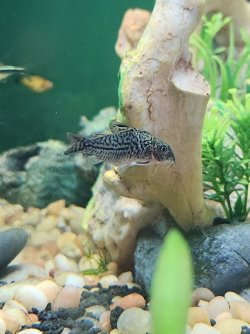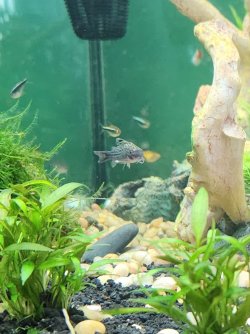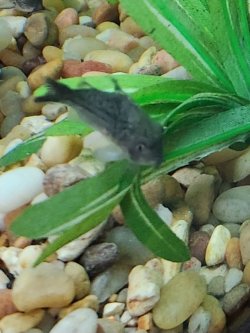It could be fungus or excess mucous on the edge of the pectoral (side) fin. It looks more like mucous than fungus.
The fish is skinny and has some minor damage to the fins. It's not a happy fish.
It might have been injured when it was caught at the shop or has injured itself in the tank since you got it. However, since there are a group of them and only one has an issue, I would say it has an underlying health issue that is weakening it and making it take longer to recover from being caught and moved to your tank.
You can try doing a big water change and gravel cleaning the substrate, cleaning the filter and adding salt. This might help. You could also deworm the fish. You use salt in the main tank with all the fish so you don't stress the sick one by chasing it and moving it, and so you kill any disease organisms in the main tank. there's no point treating a fish in a clean hospital tank if you move it back into a dirty diseased tank straight after treatment. Deworming medications should also be used in the main tank.
See section 3 of the following link for deworming fish.
Fish do a stringy white poop for several reasons. 1) Internal Bacterial Infections causes the fish to stop eating, swell up like a balloon, breath heavily at the surface or near a filter outlet, do stringy white poop, and die within 24-48 hours of showing these symptoms. This cannot normally be...

www.fishforums.net
----------------------
SALT
You can add rock salt (often sold as aquarium salt), swimming pool salt, or any non iodised salt (sodium chloride) to the aquarium at the dose rate of 1 heaped tablespoon per 20 litres of water. If there is no improvement after 48 hours you can double that dose rate so there is 2 heaped tablespoons of salt per 20 litres.
Keep the salt level like this for at least 2 weeks but no longer than 4 weeks otherwise kidney damage can occur. Kidney damage is more likely to occur in fish from soft water (tetras, Corydoras, angelfish, Bettas & gouramis, loaches) that are exposed to high levels of salt for an extended period of time, and is not an issue with livebearers, rainbowfish or other salt tolerant species.
The salt will not affect the beneficial filter bacteria, fish, plants, shrimp or snails.
After you use salt and the fish have recovered, you do a 10% water change each day for a week using only fresh water that has been dechlorinated. Then do a 20% water change each day for a week. Then you can do bigger water changes after that. This dilutes the salt out of the tank slowly so it doesn't harm the fish.
If you do water changes while using salt, you need to treat the new water with salt before adding it to the tank. This will keep the salt level stable in the tank and minimise stress on the fish.
When you first add salt, add the salt to a small bucket of tank water and dissolve the salt. Then slowly pour the salt water into the tank near the filter outlet. Add the salt over a couple of minutes.






